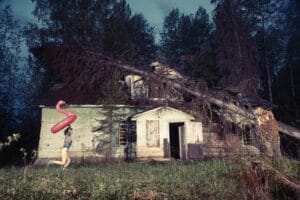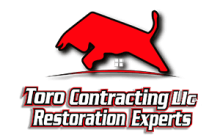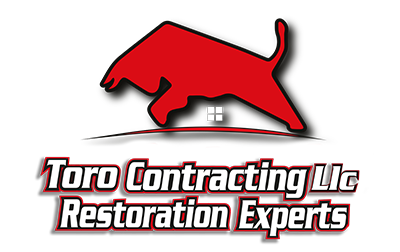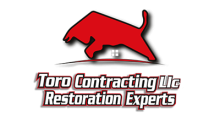After a tree falls on your roof, ascertain everyone’s safety first by evacuating and turning off utilities. Check for visible signs like sagging rooflines, displaced rafters, or compromised beams from a safe distance. Inside, look for ceiling stains, mold, or texture changes. Examine your attic for wet spots, daylight penetration, or damaged rafters. Document everything with photos for insurance claims. Distinguishing between cosmetic and structural damage requires specific techniques we’ll investigate further.
Key Takeaways
- Evacuate immediately and document visible damage from a safe distance with photographs before turning off utilities.
- Inspect for sagging rooflines, compromised support beams, and rafter displacement, which indicate serious structural damage.
- Check interior ceilings for stains, color variations, and mold that reveal water infiltration through compromised roofing.
- Examine the attic for wet spots, visible daylight, displaced insulation, and broken rafters that expose the damage extent.
- Consult licensed roofing professionals or structural engineers for comprehensive assessment and proper documentation for insurance claims.
Immediate Safety Measures Before Assessment
Before initiating any structural roof damage assessment, implementing proper safety protocols is critical. First, evacuate all occupants from the affected area and establish a safety perimeter to prevent injuries from potential secondary collapses. Contact emergency services immediately, as professionals can address immediate hazards like gas leaks, downed power lines, or fire risks.
Turn off all utilities in the building, particularly electricity, to minimize electrocution dangers when water exposure is possible. Don appropriate safety gear, including a hard hat, steel-toed boots, gloves, and safety glasses before approaching the structure. Document visible damage from a safe distance using photographs or video before closer inspection.
Wait for professional clearance if the structural integrity appears severely compromised, as safety precautions take precedence over quick assessment.
Exterior Signs of Serious Structural Damage
Identifying visible rafter displacement offers a vital first indicator of potential roof failure, appearing as tilted or shifted wooden beams that no longer maintain proper alignment. A sagging roofline often manifests as an uneven or curved profile along the roof’s edge, indicating structural fatigue or collapse beneath the surface materials. Compromised support beams may reveal themselves through cracked or fractured members, unusual deflection under load, or separation at connection points that compromise the roof’s overall structural integrity.
Visible Rafter Displacement
When examining a roof’s structural integrity, visible rafter displacement represents one of the most critical exterior indicators of compromised support systems. You’ll notice this problem when rafters shift from their original positions, creating asymmetrical roof lines or uneven ridges.
Inspect the roof’s profile from a distance to detect any sagging, bowing, or irregular rafter alignment. These deviations often manifest as a wavy appearance along the roofline or visible gaps between roofing materials. If displacement exceeds 1-2 inches, you’re facing potentially catastrophic structural failure.
Document all observations thoroughly before considering repair options. Minor displacement might require reinforcement with sister rafters, while severe cases demand complete replacement and professional engineering assessment. Postponing repairs typically leads to accelerated deterioration and substantially higher remediation costs.
Sagging Roofline Sections
A sagging roofline represents one of the most visible and alarming indicators of compromised structural integrity. When examining your home after a tree impact, stand at a distance and observe the roof’s horizontal lines. Any deviation from straight alignment suggests potential failure of supporting elements.
Look specifically for distinct dips or waves in the roofline, which typically indicate sagging rafters underneath. These depressions aren’t merely cosmetic concerns but rather critical warnings of diminished roof stability. The severity of sagging correlates directly with the urgency of professional intervention.
Document these areas photographically from multiple angles, as sagging often worsens progressively. Don’t delay assessment—even minor depressions can indicate significant internal damage that compromises the entire roofing system. Small visible sags frequently mask more extensive structural compromise requiring immediate reinforcement.
Compromised Support Beams
Support beams that have become compromised often manifest through several distinct exterior indicators that homeowners can observe without accessing the attic space. When conducting a structural assessment, identify these critical warning signs that indicate compromised integrity:
- Visible buckling or warping along exterior walls, particularly near the roofline where support beams connect to the structure
- Uneven gaps between soffit and exterior walls that weren’t present before the tree impact
- Doors or windows that suddenly stick or won’t close properly, suggesting the frame has shifted due to beam damage
- Cracking in exterior masonry or siding that forms diagonal patterns, indicating stress transfer from damaged roof supports
These observable symptoms warrant immediate professional evaluation, as they suggest potential catastrophic structural failure if left unaddressed.
Interior Indicators That Reveal Roof Compromise
Ceiling stains represent one of your most visible indicators of water infiltration through compromised roofing structures. Your attic serves as the critical intermediate inspection zone where roof leaks first manifest before causing ceiling damage below. When you conduct a thorough attic examination, pay particular attention to water trails on rafters, damp insulation, or mold growth—all revealing the true extent and location of overhead structural failures.
Ceiling Stains Speak Volumes
The interior surfaces of your home often provide the first visible evidence of potential roof damage. Ceiling stains reveal essential information about water penetration patterns and moisture concerns that demand immediate attention. When examining your ceiling materials after a tree impact event, focus on these key indicators:
- Color variations – Yellow-brown discoloration typically indicates recent water intrusion, while dark patches suggest long-term moisture exposure
- Pattern distribution – Concentric rings demonstrate intermittent leakage, whereas large uniform stains indicate sustained water flow
- Texture changes – Bubbling, sagging, or peeling signals significant water absorption in ceiling materials
- Mold presence – Black or green spotting confirms excessive moisture levels and potential health hazards
Document all stain characteristics thoroughly before remediation to establish causal links between roof damage and interior deterioration.
Attic Inspection Reveals Truth
While ceiling stains offer visible evidence of water intrusion, examining your attic space provides direct access to underlying roof damage that remains hidden from below. Armed with a flashlight, inspect the underside of roof sheathing for wet spots, mold growth, or visible daylight penetrating through compromised sections.
Evaluate attic ventilation systems for blockage or damage caused by the fallen tree, as proper airflow prevents condensation that accelerates structural deterioration. During your inspection, pay close attention to displaced or compressed insulation, which often indicates points of impact or water infiltration paths.
Document any broken rafters, cracked joists, or deformed roof planes, as these structural failures require immediate professional attention. The attic serves as your diagnostic chamber, revealing the true extent of damage and guiding repair prioritization beyond what’s visible from exterior assessment.

Distinguishing Between Cosmetic and Structural Issues
Accurate identification of roof damage requires distinguishing between cosmetic defects and structural problems. When a tree impacts your roof, the damage may manifest in various forms that affect either appearance or structural integrity. Proper assessment prevents unnecessary repairs while ensuring safety concerns aren’t overlooked.
- Surface examination – Cracked or missing shingles typically indicate cosmetic repairs, while sagging sections suggest compromised structural components
- Load-bearing assessment – Test rafters and trusses for deflection when pressure is applied; minimal movement indicates sound structure
- Water penetration testing – Moisture meters can detect hidden damage that may appear cosmetic but threatens underlying structures
- Junction inspection – Examine wall-roof connections for separation, as these critical junctions often reveal structural failures masked by minor surface damage
Professional Evaluation: When and Who to Call
Determining when to call roofing professionals requires careful consideration of damage severity and your technical limitations. Contact emergency services immediately if you observe sagging roof sections, interior ceiling collapse, or compromised load-bearing elements. These signs indicate critical structural integrity issues requiring immediate attention.
For comprehensive assessment, consult structural engineers when:
- The tree impact affected multiple roof sections
- You’ve identified displaced support beams
- Foundation movement has occurred
- Water intrusion exists near electrical systems
Select licensed professionals with specific tree damage experience and insurance claim expertise. Request documentation of their findings, including detailed structural analysis and photographic evidence. This documentation proves invaluable for insurance claims and establishing repair priorities based on safety concerns rather than cosmetic considerations.
Documentation Steps for Insurance Claims and Repairs
The process of properly documenting roof damage forms a critical component of both successful insurance claims and effective repair planning. Thorough insurance documentation serves as evidence of damage extent and repair requirements, while forming the foundation for accurate repair estimates.
Follow these essential documentation steps:
- Capture comprehensive photographs of all visible damage, including wide shots and close-ups, with timestamps and location markers
- Maintain a detailed written record describing damage specifics, weather conditions during the incident, and chronological sequence of events
- Obtain multiple professional repair estimates from licensed contractors, specifying materials, labor costs, and projected timelines
- Preserve all communication records with insurance representatives, including claim numbers, adjuster information, and inspection dates
This systematic documentation approach guarantees maximum claim reimbursement potential while facilitating precise repair planning and execution.
Frequently Asked Questions
Can I Repair Small Structural Roof Damage Myself?
While DIY repairs may seem cost-effective, structural roof damage requires professional expertise. You shouldn’t attempt to repair even small structural issues yourself as they affect your home’s integrity. If you insist on DIY repairs, limit yourself to temporary protective measures like covering exposed areas with tarps. Always prioritize safety precautions: use proper fall protection equipment and avoid work during adverse weather conditions. Structural components demand precise engineering calculations and specialized construction techniques that most homeowners lack.
How Long Can Temporary Roof Repairs Safely Last?
Temporary roof repairs typically last 3-6 months depending on the materials used and weather conditions. You’ll need to conduct a thorough roof damage assessment to determine if your temporary solution is holding. Quality temporary repair materials like heavy-duty tarps, roofing cement, and properly sealed flashing can extend this timeframe to nearly a year. However, you should arrange permanent repairs as soon as possible, as prolonged temporary fixes increase the risk of secondary structural damage.
Will My Homeowners Insurance Premium Increase After Filing a Claim?
Your homeowners insurance premium may increase after filing a claim, but it’s not guaranteed. Premium increase factors include your claims history, claim amount, and policy terms. Most insurers analyze risk patterns when evaluating rate adjustments. The insurance claim process typically triggers a review at renewal time. Some companies offer claim forgiveness programs that protect against increases. It’s advisable to compare the claim amount against your deductible and potential premium hikes before filing.
Can I Stay in My Home During Structural Roof Repairs?
Like walking on thin ice, staying in your home during structural roof repairs requires careful assessment. Safety should guide your decision, contingent upon the damage’s extent and your contractor’s professional consultation. Temporary living arrangements may be necessary if repairs involve extensive demolition, compromise structural integrity, or expose hazardous materials. The technical evaluation must consider electrical safety, weather exposure, and structural stability before determining habitability during the rehabilitation process.
What Building Permits Are Required for Structural Roof Replacement?
Building permits are required for structural roof replacement in most jurisdictions. You’ll need to submit a permit application to your local building department, which typically requires detailed plans showing compliance with building codes. Requirements vary by location but generally include structural calculations, material specifications, and contractor information. Some areas also mandate inspections at different stages of the project. Check with your municipal building department as unpermitted work can result in fines and complications during property sales.






